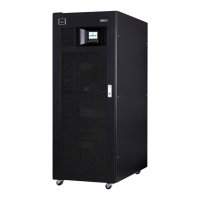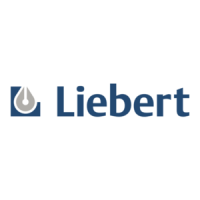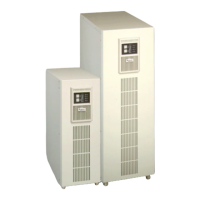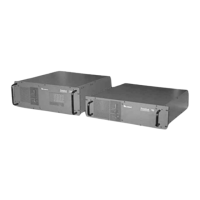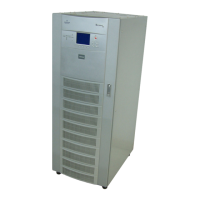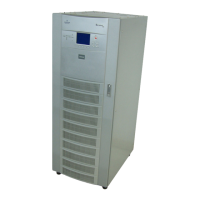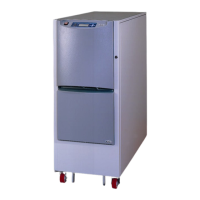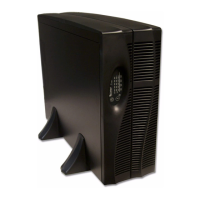Do you have a question about the Liebert 30-130kVA and is the answer not in the manual?
Overview of the Npower Uninterruptible Power System (UPS), its features, principles, and functions.
Discusses the design goals and standards for Liebert UPS systems, including MTBF and certifications.
Highlights the Npower's customizable features and options tailored to specific user needs.
Outlines critical safety measures and warnings required when working with the UPS and batteries.
Details the different operational states of the UPS, such as Normal, Input Power Failure, and Recharge.
Describes the microprocessor-based operator display screen and control panel for system operation.
Lists and briefly explains standard pre-designed options available for the UPS system.
Explains the main components of the UPS system, including the UPS module and battery plant.
Provides in-depth descriptions of hardware and firmware features of the UPS module.
Details the location and function of controls on the UPS module cabinet door and inside.
Explains the password protection system to prevent unauthorized configuration of the UPS.
Guides users through the various screens accessible via the Operator Interface Display System.
Describes the two scenarios for starting up the UPS, including auto and manual procedures.
Details how to shut down the UPS, including options for inverter off and critical load shutdown.
Explains how to manually transfer the critical load between the UPS and bypass using the static bypass switch.
Covers battery self-tests, equalization, temperature compensation, and cycle monitoring.
Explains how the UPS can automatically restart after a shutdown due to input power loss.
Details how to access and interpret system status data, including operating hours and accumulated events.
Defines faults, their causes, and associated system actions, with a list of fault messages.
Explains alarms as indicators of abnormal conditions and their potential impact on UPS operation.
Describes the Summary Alarm that captures individual faults and alarms for quick status overview.
Provides information on UPS operational status indicated by text messages and graphical representations.
Explains how to use the RS-232 port for transmitting UPS status and history information.
Covers connecting to external modems for remote UPS configuration and monitoring.
Describes the optional panel providing LED indications for critical alarm conditions.
Details how SiteScan port sends UPS information to a central monitoring system.
Guides on connecting external devices like modems, printers, and terminals to the UPS.
Illustrates the power flow when the UPS is not available or during maintenance.
Explains the status message indicating when a transfer between bypass and UPS is permitted.
Describes how the UPS handles short-duration overloads and parallel operation with the bypass line.
Explains how the battery plant supplies power to the inverter during utility AC power failure.
Details automatic UPS functions like overload handling and transfers to bypass/retransfers to UPS.
Reiterates safety measures for performing maintenance on the UPS and associated equipment.
Guides on regular maintenance tasks like record keeping, cleaning, and checking connections.
Advises on checking instrument readings and UPS display screens for performance issues.
Instructs on how to report UPS problems to Liebert Global Service.
Directs users to find recommended corrective actions for alarms on the control panel.
Lists essential test equipment and tools for UPS maintenance and troubleshooting.
Overview of the Npower Uninterruptible Power System (UPS), its features, principles, and functions.
Discusses the design goals and standards for Liebert UPS systems, including MTBF and certifications.
Highlights the Npower's customizable features and options tailored to specific user needs.
Outlines critical safety measures and warnings required when working with the UPS and batteries.
Details the different operational states of the UPS, such as Normal, Input Power Failure, and Recharge.
Describes the microprocessor-based operator display screen and control panel for system operation.
Lists and briefly explains standard pre-designed options available for the UPS system.
Explains the main components of the UPS system, including the UPS module and battery plant.
Provides in-depth descriptions of hardware and firmware features of the UPS module.
Details the location and function of controls on the UPS module cabinet door and inside.
Explains the password protection system to prevent unauthorized configuration of the UPS.
Guides users through the various screens accessible via the Operator Interface Display System.
Describes the two scenarios for starting up the UPS, including auto and manual procedures.
Details how to shut down the UPS, including options for inverter off and critical load shutdown.
Explains how to manually transfer the critical load between the UPS and bypass using the static bypass switch.
Covers battery self-tests, equalization, temperature compensation, and cycle monitoring.
Explains how the UPS can automatically restart after a shutdown due to input power loss.
Details how to access and interpret system status data, including operating hours and accumulated events.
Defines faults, their causes, and associated system actions, with a list of fault messages.
Explains alarms as indicators of abnormal conditions and their potential impact on UPS operation.
Describes the Summary Alarm that captures individual faults and alarms for quick status overview.
Provides information on UPS operational status indicated by text messages and graphical representations.
Explains how to use the RS-232 port for transmitting UPS status and history information.
Covers connecting to external modems for remote UPS configuration and monitoring.
Describes the optional panel providing LED indications for critical alarm conditions.
Details how SiteScan port sends UPS information to a central monitoring system.
Guides on connecting external devices like modems, printers, and terminals to the UPS.
Illustrates the power flow when the UPS is not available or during maintenance.
Explains the status message indicating when a transfer between bypass and UPS is permitted.
Describes how the UPS handles short-duration overloads and parallel operation with the bypass line.
Explains how the battery plant supplies power to the inverter during utility AC power failure.
Details automatic UPS functions like overload handling and transfers to bypass/retransfers to UPS.
Reiterates safety measures for performing maintenance on the UPS and associated equipment.
Guides on regular maintenance tasks like record keeping, cleaning, and checking connections.
Advises on checking instrument readings and UPS display screens for performance issues.
Instructs on how to report UPS problems to Liebert Global Service.
Directs users to find recommended corrective actions for alarms on the control panel.
Lists essential test equipment and tools for UPS maintenance and troubleshooting.
